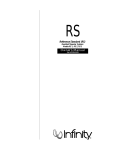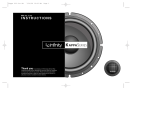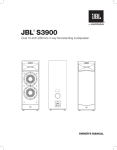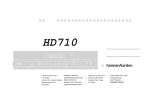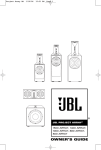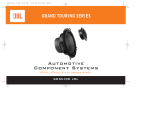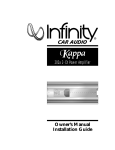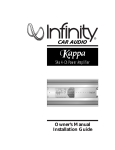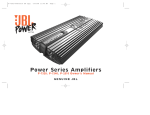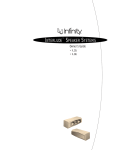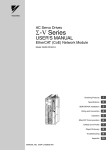Download JBL 4344MKII User's Manual
Transcript
4344 MK 11 Manual 7/21/98 3:18 PM Page 16 4344MkII P R O F E S S I O N A L L O U D S P E A K E R S E R I E S S Y S T E M A NEW STANDARD FOR A NEW CENTURY 4344 MK 11 Manual 7/21/98 3:18 PM Page 14 JBL is part of the Harman International family of audio companies, a group with a common purpose: combining technology with a love of music to manufacture audio products that provide new levels of satisfaction, performance and value. To promote diversity and creativity, JBL operates independently in research and development. When it comes to translating the results of these efforts into actual consumer and professional products, JBL draws on the full combined strength of the Harman companies, including one of the world’s most advanced manufacturing facilities. The result of this teamwork is that JBL’s renowned excellence in engineering is successfully carried through to each individual product, regardless of its application or price range. As new audio concepts and technologies are pioneered, the partnership of JBL and Harman International guarantees that consumer and professional audio users everywhere will be able to enjoy their full benefits. RAT S G 5 0 EB IN CEL JBL continually engages in research related to product development and improvement. Because of this, new materials, production methods and design refinements may be introduced into existing products without notice. For this reason, any current JBL product may differ in some respect from its published description, but will always equal or exceed the original design specifications unless otherwise stated. YEAR 4344 MK 11 Manual 7/21/98 3:18 PM Page 2 Table of Contents Low-Frequency Transducer 4 Mid-Frequency Transducer 5 High-Frequency Transducer 5 Ultrahigh-Frequency Transducer 5 Dividing Networks 6 Battery Replacement 7 Placement 8 Speaker Connections 9 Bi-Wiring 10 Maintenance and Service 13 System Specifications 14 Declaration of Conformity We, JBL Europe A/S Kongevejen 194B DK-3460 Birkerød DENMARK JBL Consumer Products 80 Crossways Park West, Woodbury, NY 11797 8500 Balboa Boulevard, Northridge, CA 91329 1-800-336-4JBL (4525) (USA only) www.jbl.com ©1996 JBL, Incorporated. JBL is a registered trademark of JBL, Incorporated. Printed in USA 2/97 Part No. 4344MkIIOM97 A Harman International Company declare in own responsibility, that the loudspeakers described in this owner’s manual are in compliance with technical standards: EN 50 081-1/1992 EN 50 082-1/3.1995 Steen Michaelsen JBL Europe A/S Birkerød. DENMARK. 2/97 4344 MK 11 Manual 7/21/98 3:18 PM Page 3 With the Professional Series 4344MkII Loudspeakers, JBL combines the most advanced technology with a classic JBL design. These speakers continue the longstanding tradition of precise studio monitor sound for which JBL is famous. You will enjoy the benefits of a 2" highfrequency compression driver, cast frame low-frequency transducers with vented pole pieces, and JBL’s proprietary Symmetrical Field Geometry magnet design, as well as high definition dividing networks incorporating the highest quality electronic components available. Low-Frequency Transducer No. 4 The 4344MkII features an all-new 15" (381mm) low-frequency transducer developed specifically for the 4344MkII. Derived from JBL’s legacy of highly powerful yet efficient bass drivers, this woofer delivers full low-frequency performance with clarity and speed unprecedented among 15" drivers. The voice coil is 4" (102mm) in diameter and wound on edge from flat aluminum ribbon wire on a thermoset composite™ form. The cone is a rigid paper composite, treated with Aquaplas™ for strength, speed, and damping. JBL’s Symmetrical Field Geometry is employed in the form of an aluminum sleeve around the pole piece. This sleeve reduces second-order distortion through induced flux control. Its aluminum composition is also a more efficient conductor of heat, so it assists in dissipating heat away from the voice coil to extend the power capacity. Cooling of the voice coil is further enhanced by the use of a vented pole piece. The rigid frame is cast from aluminum alloy, an excellent thermal conductor, which further acts to efficiently draw heat away from the voice coil and magnet assembly. This combination of advanced design technology results in a bass driver that is remarkably free from dynamic restriction due to heat buildup. 4344 MK 11 Manual 7/21/98 3:18 PM Page 4 Mid-Frequency Transducer The 4344MkII also features a 10" (254mm) mid-frequency transducer. The voice coil is 3" (76mm) in diameter and wound on edge from flat copper ribbon wire on a thermoset composite™ form. Its very high-power capability and freedom from breakup make it an ideal midrange in a system that is designed to play at high levels with absolutely no signs of distress. It makes the transition from the woofer at 340Hz, providing excellent response throughout the important vocal range. High-Frequency Transducer Throughout the history of high-frequency transducer design, the goal of extended frequency response has been at odds with the need for high power handling. The 4344MkII utilizes a 2" compression driver with an Aquaplas-coated titanium dome. JBL has long chosen titanium as the material for its highest-quality high-frequency transducers and the 4344MkII is no exception. Titanium possesses the essential requirements for a high-frequency transducer. First, titanium is extremely light, yet rigid. The goal is to maintain a piston-like action as high in frequency as possible. Should the material flex easily, the diaphragm will break up into random vibrations. Second, titanium is virtually immune to fatigue, unaffected by the cumulative effect of millions of flexures over long operating periods. These factors coupled with the higher power handling that titanium affords, allow us to produce an extremely smooth highfrequency transducer with extended frequency response that can handle all the demands of today’s digital programs. The Horn/Lens assembly ensures controlled distribution of the high frequencies, resulting in a wide soundstage with pinpoint imaging. ultrahigh-Frequency Transducer For the ultrahigh-frequency transducer, we chose a 1-3/4" compression driver with an edge-wound aluminum voice coil. This driver reproduces all of the ultrahigh frequencies above 8000Hz with incredible clarity and detail. No. 5 4344 MK 11 Manual 7/21/98 3:18 PM Page 5 Dividing Networks The job of the dividing network is to distribute the various frequencies to their respective transducers. The network is also designed to complement component location on the baffle. Slopes are chosen to match the exact response of each driver in its respective frequency range, as well as to ensure that the high-frequency transducers are adequately protected from dangerous low-frequency components. Professional Series No. Model 4344MkII Serial Number: JBL Incorporated, Northridge, CA USA 6 For the 4344MkII system, we chose our Charge-Coupled Linear Definition™ Dividing Network. The inductors are all designed for highcurrent, low-distortion operation. All capacitors in the network are series/parallel connected and operated with D.C. bias. This effectively enables the capacitors to operate in “Class A” mode, which substantially increases sonic detail, resolution, and dynamics. The low-frequency section of the dividing network is mounted on a dedicated circuit board that separates both electrical and magnetic properties from that of the midrange and tweeter sections. ULTRA HIGH FREQUENCY LEVEL, dB – 2.5 – 6.5 0 –∞ +1.5 HIGH FREQUENCY LEVEL, dB – 2.5 – 6.5 0 –∞ +1.5 MID FREQUENCY LEVEL, dB – 2.5 – 6.5 –∞ 0 +1.5 Level adjustments are provided to allow precision frequency response contouring. The midrange, high-frequency, and ultrahigh-frequency drivers may be fine-tuned for optimum sound in any listening room. Additionally, the 4344MkII’s dividing network allows for passive, bi-wire, passive bi-amp, and full active bi-amp operation. For the full active bi-amp mode we recommend the use of a high-quality electronic crossover. 4344 MK 11 Manual 7/21/98 3:18 PM Page 6 Battery Replacement The battery should be replaced approximately every 2 years. This is accomplished as follows: • Unscrew the two screws that hold the battery access cover in place. It is located on the upper portion of the dividing network, on the rear of the speaker enclosure (Figure 1). • Write today’s date, including the year, in this manual. • Install the battery by aligning the battery terminals with the mating terminals in the network housing. Align male to female, female to male terminals, then snap the connectors together, assuring a tight connection. • Replace the battery access cover and install screws. Figure 1 Battery Installation BI-AMP BATTERY NORMAL/ BI-WIRE JBL INCORPORATED 8500 Balboa Blvd., Northridge, CA USA High Frequency Low Frequency Battery Replacement Record Date Installed: No. 7 4344 MK 11 Manual 7/21/98 3:18 PM Figure 2 Placement Page 7 Placement 3' 3' Position Top View 3' 3' 10 – 15 10 – 15 Position Front View 3' 3' Ear level when seated in listening position No. 8 Ideally the systems should be placed at least three feet from any walls. The height, at the bottom of the Lens assembly, should be at ear level. The two speakers should be equidistant from your primary listening position; the distance should be determined by the distance between the speakers. We recommend that the angle between the speakers, at the listening position, be between 45° to 60°. For example, if the speakers are 8' apart, your listening position should be 8'–12' from each speaker. To widen the area in which the best stereo image will be perceived, turn the speaker to face the primary listening position (Figure 2). It is normally recommended that the 4344MkII loudspeakers be positioned so that the ultrahigh-frequency transducers are towards the outside. In some listening environments, however, the imaging characteristics may be improved by positioning the ultrahigh-frequency transducers towards the inside. We suggest you experiment with the positioning of your loudspeakers to determine the ideal placement in your listening room. 4344 MK 11 Manual 7/21/98 3:18 PM Page 8 Speaker Connections The 4344MkII loudspeakers can be connected by one of several methods. The binding posts on the rear panel of the 4344MkII will accept most types of audio cable and connectors, including banana plugs and bare wire (Figure 3). Follow the hookup method that best describes your system. Figure 3 Connections Bare Wire Connecting Method JBL INCORPORATED 8500 BALBOA BLVD. NORTHRIDGE, CA USA HIGH FREQUENCY LOW FREQUENCY Standard Connections (Figure 4) 1. For each channel, connect the red (+) terminal on the 4344MkII to the red (+) terminal on your amplifier. 2. For each channel, connect the black (–) terminal on the 4344MkII to the black (–) terminal on the amplifier. Banana/Spade Connecting Method JBL INCORPORATED 8500 BALBOA BLVD. NORTHRIDGE, CA USA HIGH FREQUENCY LOW FREQUENCY Connecting the systems in this manner ensures that they will operate in phase; that is, they will work together rather than in opposition. Connecting the speaker system out of phase will not cause damage but will adversely affect the speaker’s sound. No. 9 Figure 4 Standard Connecting Method JBL INCORPORATED 8500 BALBOA BLVD. NORTHRIDGE, CA USA HIGH FREQUENCY LOW FREQUENCY 4344 MK 11 Manual 7/21/98 3:18 PM Page 9 Bi-Wiring The 4344MkII’s outer connection panel and internal dividing network are designed so that separate sets of speaker cable can be attached to the low-frequency transducer and midrange/high-frequency transducer portions of the dividing network. This is called bi-wiring. Bi-wiring can provide several sonic advantages and considerably more flexibility in power amplifier selection. The advantages of bi-wiring are as follows: Reduction of Intermodulation No. 10 The majority of current flowing between an amplifier and speaker is devoted to bass reproduction. In fact, 60% or more of an amplifier’s output is destined for the woofers. When current flows through a wire, it produces an electro-magnetic field (EMF) that expands and collapses at a rate equal to that of the music’s complex frequency components. If a single speaker wire must conduct the full musical frequency, the preponderance of lowfrequency information can interact with or modulate high frequencies. The resulting intermodulation can create audible changes to the high frequencies even before they reach the loudspeakers. By using separate cables for high and low frequencies, unwanted highfrequency modulation is avoided. Low-frequency information flows through one cable while high frequencies flow through another. Frequency-optimized Cables Having the opportunity to use separate low- and high-frequency cables allows you to use cables best suited to each frequency range. Optimally, you should use high-quality, audiophile-grade speaker cables for both lowand high-frequency conductors. However, let your ears guide you to the cables that best match the 4344MkII loudspeakers to your amplifier. Amplifier Flexibility Bi-wiring also allows you the option of using separate stereo power amplifiers for left and right speakers, or even four mono amplifiers. Whether you use two or four amplifiers, it is important to use the same brand and model to power like connections on the 4344MkII. 4344 MK 11 Manual 7/21/98 3:18 PM Page 10 Bi-Wiring Connections Figures 5 through 8 show two bi-wiring options, single-stereo amplifier and dual-stereo amplifier modes. For passive and bi-wire connections, set the switch to the Normal/Bi-Wire position (Figure 5a). Figure 5 Bi-Wire Connecting Method AMP NORMAL/ BI-WIRE JBL INCORPORATED 8500 BALBOA BLVD. NORTHRIDGE, CA USA HIGH FREQUENCY LOW FREQUENCY Important 1. The external “strapping bars” that normally connect the 4344MkII low-frequency and high-frequency terminals must be removed before bi-wiring. To remove the shorting straps, simply loosen and slide the bars off to the side (Figure 8). Figure 5a Normal/Bi-Wire Position Bi-AMP NORMAL/ BI-WIRE Figure 6 One-Amp Bi-Wire 2. Never connect two amplifiers to the same loudspeaker without first removing the strapping bars. Operating two amplifier channels without removing the strapping bars can seriously damage your amplifiers! Preamp HF LF HF LF Stereo amp 3. If you have hooked up your 4344MkII loudspeakers in any of the bi-wire configurations indicated, it is not advisable to use additional speakers separately or simultaneously. No. Figure 7 Two-Amp Bi-Wire 4. As with conventional one-amplifier connections, make sure that all speaker cables are the same length. 11 Preamp w/Y-corded output HF LF HF LF Stereo amps Figure 8 Removal of Shorting Straps AMP NORMAL/ BI-WIRE JBL INCORPORATED 8500 BALBOA BLVD. NORTHRIDGE, CA USA HIGH FREQUENCY LOW FREQUENCY 4344 MK 11 Manual 7/21/98 3:18 PM Figure 9 Bi-Amp Connecting Method AMP NORMAL/ BI-WIRE JBL INCORPORATED 8500 BALBOA BLVD. NORTHRIDGE, CA USA HIGH FREQUENCY LOW FREQUENCY Figure 9a Bi-Amp Switch Setting BI-AMP BATTERY No. 12 NORMAL/ BI-WIRE Page 11 Bi-Amping Connections The optimal method of powering the 4344MkII system is with two amplifiers, one for low frequencies and one for the mid/high frequencies. It is necessary to use a high-quality active crossover module. Since each amplifier only drives a limited frequency range, this method allows the user to select amplifiers with the desired sonic character for low and high frequencies. Make sure that the input sensitivity of each of the amplifiers is the same, or that input level controls are provided to maintain the proper low-tomid/high balance. If two identical stereo amplifiers are used, one may be located near each loudspeaker to drive low- and mid/high-frequency sections through short wire runs. The external “strapping bars” that normally connect the 4344MkII low-frequency and high-frequency terminals must be removed before bi-amping. To remove the shorting straps, simply loosen and slide the bars off to the side (Figure 8). If the system is wired in the bi-amp method, set the Bi-Amp/Normal switch to the Bi-Amp position (Figure 9 and Figure 9a). 4344 MK 11 Manual 7/21/98 3:18 PM Page 12 Maintenance and Service The 4344MkII loudspeaker systems have an oiled finish. Cleaning should be done with an untreated dust cloth. Do not use conventional furniture waxes and polishes, which are not designed for oiled finishes. If touch-up is necessary or the finish appears to be drying out, the surface may be re-oiled with a commercially available oil-finishing preparation. Do not use any solvents on the finish. The grille may be gently vacuumed. Stains may be removed with an aerosol cleaner, following the cleaner's instructions. Do not use any solvents on the grille. All wiring connections should be inspected and cleaned or remade periodically. The frequency of maintenance depends on the metals involved in the connections, atmospheric conditions, and other factors, but once per year is the minimum. The battery should be replaced approximately every three years. Consult your JBL dealer for specific recommendations. If a problem occurs, make sure that all connections are properly made and clean. If a problem exists in one loudspeaker, reverse the speaker wires to the left and right system. If the problem remains in the same speaker, then the fault is with the loudspeaker. If the problem appears in the opposite speaker, the cause is in another component or cable. In the event that your 4344MkII loudspeaker system ever needs service, contact your local JBL dealer. No. 13 4344 MK 11 Manual 7/21/98 3:18 PM Page 13 System Specifications Frequency Response: 30Hz – 22kHz –6dB Sensitivity: 95dB for 2.83V @ 1 meter Recommended Maximum Power Handling: 200 watts continuous 800 watts peak Nominal Impedance: 6 ohms Crossover Frequencies: 340Hz, 1300Hz, 8000Hz Low-Frequency Transducer: ME150H Mid-Frequency Transducer: 2123H High-Frequency Transducer: 275ND Ultrahigh-Frequency Transducer: 2405H Tuning Frequency of Woofer: 32Hz Dimensions (HxWxD): 41-3/8 x 25 x 17" 1051 x 635 x 432 mm Weight: 180 lbs 82 kg No. 14














